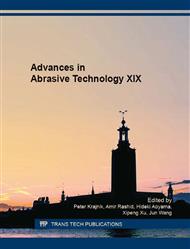p.145
p.151
p.158
p.167
p.172
p.178
p.187
p.193
p.199
Experimental Research on Dressing Parameters of the Plate in Planetary Double-Sided Grinding Process
Abstract:
Dressing parameters, which directly affect the flatness of the plate, are very important in planetary double-sided grinding dressing process. In this paper, trajectory and velocity equations of grit are studied. By comparing to the trajectory density of different annular regions, this paper puts forward an evaluation method of the shape of the plate and explores the impact of rotation speed on the shape of the plate. Finally, the experiments are performed by adjusting the rotation speed of the sun wheel and the plate. The results show that the flatness of the plate can be dressed below 0.01 mm, which validates the correctness of the theory.
Info:
Periodical:
Pages:
172-177
Citation:
Online since:
October 2016
Authors:
Price:
Сopyright:
© 2016 Trans Tech Publications Ltd. All Rights Reserved
Share:
Citation:


